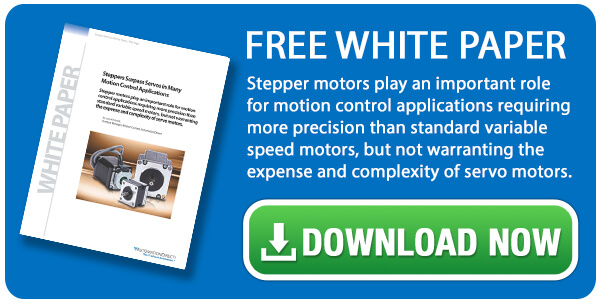Stepper motors can be the best option, even for precision motion control applications, while avoiding the expense and complexity of servo motors.

Standard AC induction and DC motors can only produce basic motion control, and servo motor solutions provide exceptional performance but drive up costs and complexity. For many motion control applications, stepper motor solutions occupy the sweet spot for providing good precision and exceptional value.
An AutomationDirect white paper titled Steppers Surpass Servos in Many Motion Control Applications describes stepper motor concepts, details, and applications where they are the best option. Following is a summary, click on the preceding link to access the entire white paper.
Electric Motor Control Options
Electric motor-driven motion control of any type usually involves a motor, drive, controller, and a power supply—either as individual components, or sometimes combined in one or two housings.
AC induction and DC motors are considered the easiest to install and maintain, and they can be configured to provide variable speed and reversing operation. However, steppers or servos are generally needed to obtain true motion control performance.
Stepper motors are commanded to move in small discrete steps using pulses, which can be rapidly generated for smooth motion. Typical designs use DC power and are good for lower speeds and forces, but newer AC-powered high bus voltage versions provide improved speed and torque characteristics.
Servo motors provide high speeds, full torque throughout the speed range, and ultra-precise control. But the hardware costs and configuration complexity are among the highest for motor control, perhaps up to four times the expense of implementing a stepper solution.
Stepper Details
To help designers decide whether stepper motors are the best fit for their applications, this white paper examines many stepper motor details, features, and benefits such as:
- Open loop versus closed loop control.
- Step modes and resolution: full-step, half-step, quarter-step, and microstepping.
- Balancing accuracy, smoothness, speed, and force.
- Stepper controllers, and motion types: fixed velocity, absolute step moves, velocity changing linear moves, trapezoidal moves, and S-curve moves.
- Using PLCs, micro-controllers, or PCs with stepper motor controllers.
- Pulse, signaling, and networking protocol types.
- Homing and position verification.
- Using stepper motors with incremental or absolute encoders.
- Stepper motor sizing.
Stepper motors can be an advantageous choice for many applications, and when they are suitable, they will be the most cost-effective option. For low-force applications where accurate single-axis or limited multi-axis motion control is needed, stepper motors and drives used in conjunction with position switches and/or an encoder will reliably operate machinery at perhaps 25% the cost of servo motor systems. AutomationDirect offers an online stepper selection tool, customer assistance, and a wide variety of associated parts and technologies to help users implement the best solution for their application.


